Carbonnades à la Flamande: The Ultimate Belgian Beer Beef Stew for Hearty Comfort
There’s nothing quite like a warm, savory stew to bring a sense of comfort and coziness back into your life, and Carbonnades à la Flamande is a true masterpiece of this culinary art. Also known as Belgian Beer Beef Stew, this delightful dish offers a unique twist on traditional French stew by swapping red wine for a robust Belgian beer. The result is a deeply rich, slightly bitter, and incredibly flavorful experience that will tantalize your taste buds and transport you straight to the heart of Europe. While often associated with French cuisine, especially in honor of occasions like Bastille Day, this particular stew beautifully embodies the rich cultural tapestry woven between France and its northern neighbor, Belgium, making it a truly special and comforting meal.
Carbonnades à la Flamande (aka Belgian Beer Beef Stew) is a savory way to bring a little comfort back into yo’ life. In honor of Bastille Day, this French stew is made with beer instead of traditional red wine, giving it a rich and slightly bitter flavor to tickle your taste buds with. Vive la France!
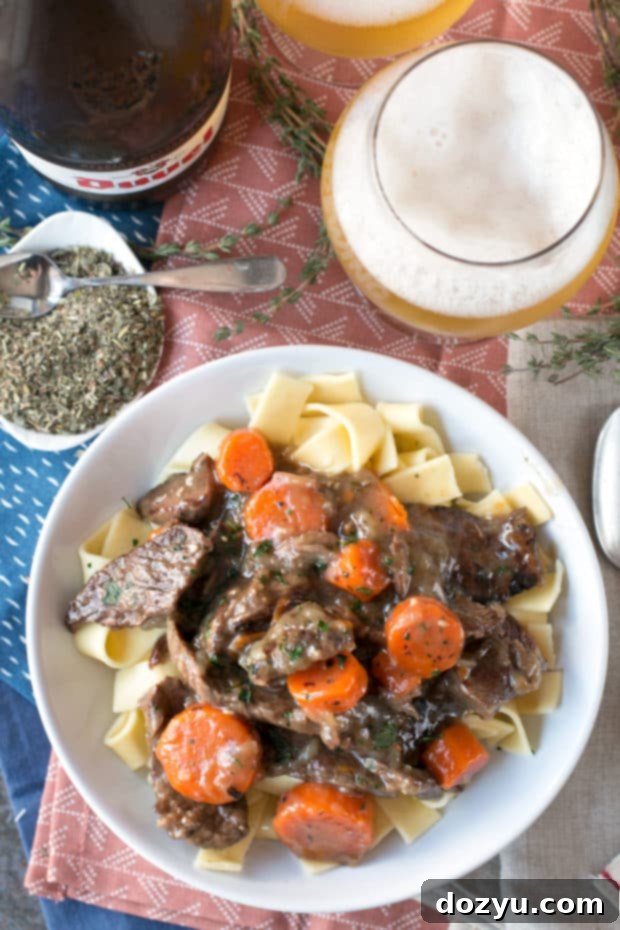
Disclosure: This post is sponsored by Sprouts. While I was compensated, as always, all opinions and the recipe are my own. Thanks for supporting the brands that support Cake ‘n Knife!
My Culinary Journey: A Deep Dive into Belgian Beer
My profound appreciation for Belgian beer truly blossomed after a memorable journey across the Atlantic to Belgium. Before that trip, I enjoyed a good beer, but the sheer diversity and craftsmanship of Belgian brews opened my eyes to a whole new world of flavor. From the deep, complex notes of Trappist ales brewed by monks to the crisp, golden perfection of their signature ales, every sip was a revelation. These beers are consistently flavorful, remarkably well-balanced, and boast a complexity that sets them apart from many other global varieties. The Belgian brewing tradition is centuries old, resulting in a mastery of fermentation and ingredient selection that produces beers perfect for both drinking and cooking.
Ever since returning from Europe, I’ve been captivated by the idea of incorporating these magnificent beers into my cooking. I often found myself brainstorming the best culinary applications for them, dreaming up dishes that could truly showcase their unique characteristics. The robust malty flavors, subtle sweetness, and occasional peppery notes found in Belgian ales make them an exceptional base for braising meats, adding layers of depth that wine alone can’t quite replicate.
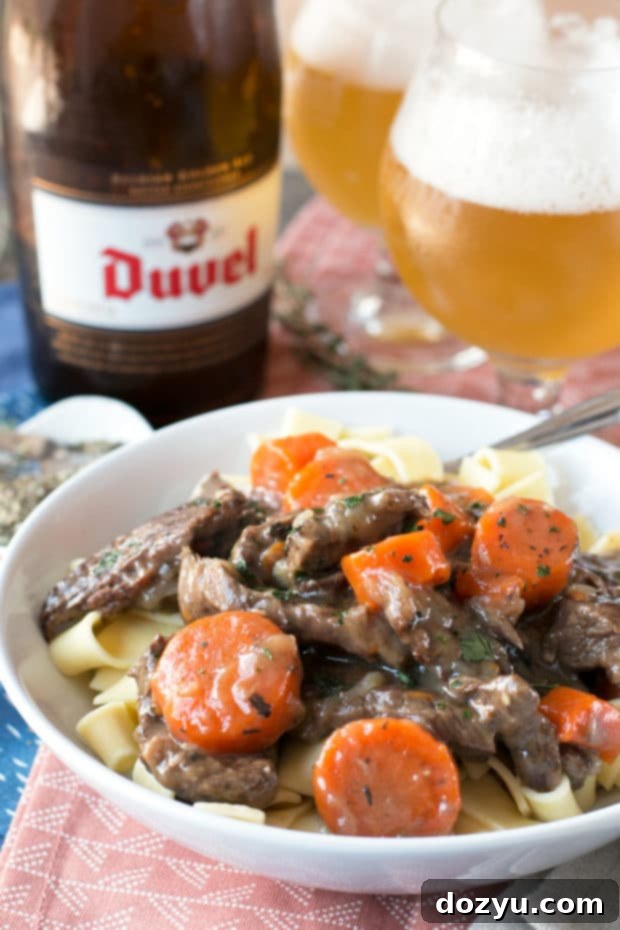
Bastille Day Inspiration & The Franco-Belgian Heritage
As Bastille Day approached, bringing with it the vibrant spirit of French celebration and a desire to explore classic French cuisine, an exciting opportunity arose. Sprouts reached out, asking me to create a special meal to honor the occasion. Suddenly, all my culinary ponderings clicked into place. What better way to pay homage to French heritage, while also indulging my newfound love for Belgian beers, than to craft a French beef stew with a distinctly Belgian twist? It was the perfect moment to delve into the treasure trove of French recipes my grandmother had lovingly passed down to me, and adapt one for this unique, cross-cultural fusion.
Carbonnades à la Flamande, in particular, perfectly encapsulates this blend. Its name, “à la Flamande,” literally means “in the Flemish style,” directly referencing Flanders, a region that historically spans parts of northern France and western Belgium. This culinary connection highlights the deep, intertwined cultural influences that have shaped the cuisines of these neighboring lands for centuries.
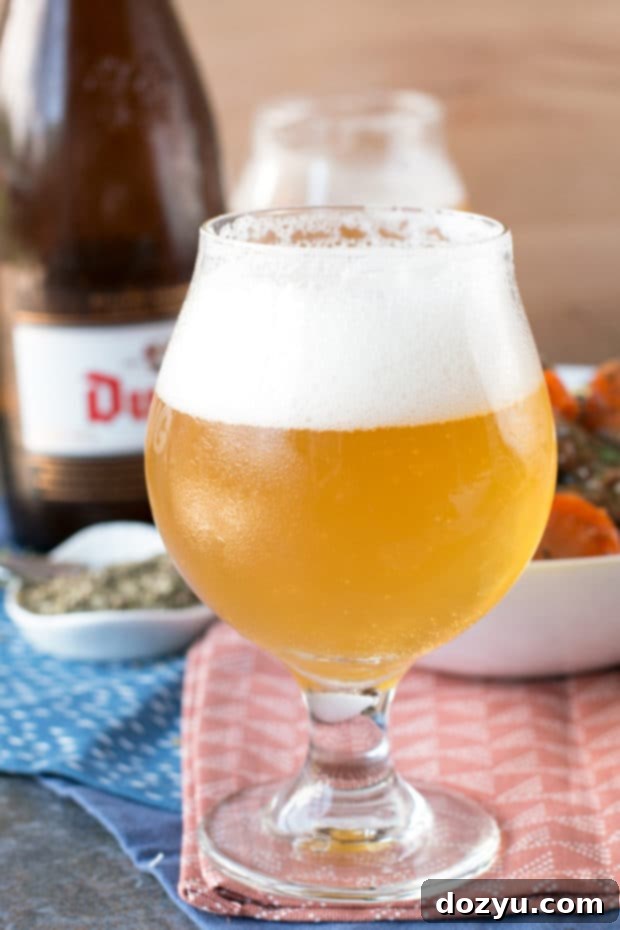
Please note that some of the links below are affiliate links. If you make a purchase through one of these links, I will receive a small commission. Thank you for supporting Cake ‘n Knife!
The Franco-Belgian Connection: Why Belgian Beer in a “French” Stew?
You might initially wonder why I’d introduce Belgian beer into what is often categorized as a French recipe. However, the story of Carbonnades à la Flamande is a beautiful illustration of culinary cross-pollination between neighboring regions. Given the geographical proximity and extensive shared history between Belgium and France, it’s no surprise that their cultures, including their beloved cuisines, have influenced each other deeply. Borders on a map don’t always dictate culinary traditions, and often, the most delicious dishes emerge from these cultural intersections.
With an abundance of exceptional beer crafted right next door in Belgium, it’s only natural that these fantastic brews would find their way into the cooking traditions of the French border regions. This delicious stew is a testament to embracing the best of both worlds, creating a dish that is both familiar in its comfort and excitingly distinct in its flavor profile. It celebrates the best of both French stewing techniques and rich Belgian brewing.
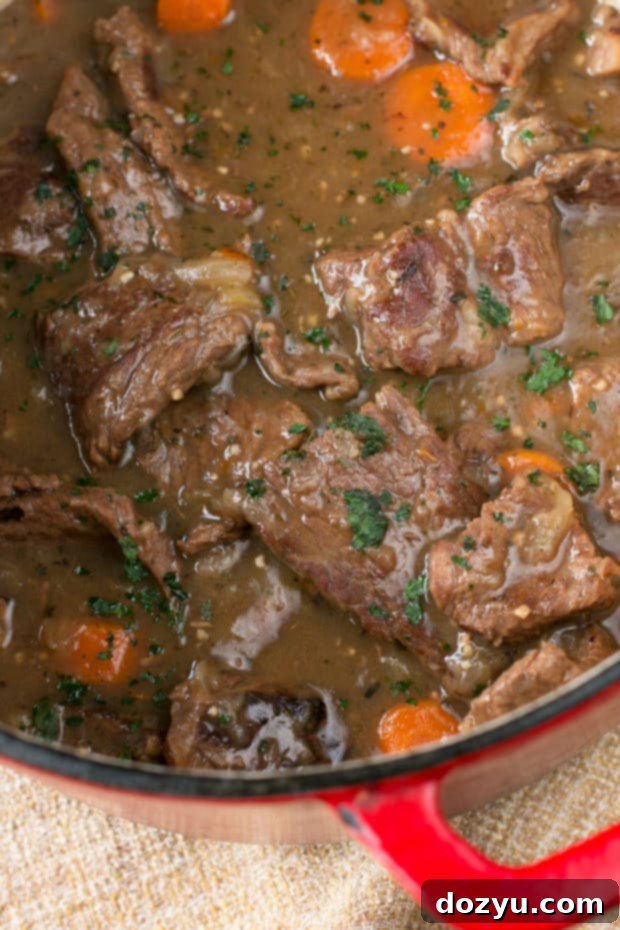
Carbonnades à la Flamande vs. Boeuf Bourguignon: A Flavorful Distinction
If you’re already acquainted with the famous French classic, Boeuf Bourguignon, then you’re halfway to understanding the comforting foundation of Carbonnades à la Flamande. Both are robust beef stews, slow-cooked to perfection, but their defining braising liquids create wonderfully distinct flavor profiles. While Boeuf Bourguignon traditionally relies on red wine, lending it a rich, tannic, and often earthy depth, Carbonnades à la Flamande proudly distinguishes itself by embracing a golden ale from Belgium.
This simple substitution of beer for wine makes a world of difference. The beer introduces a unique malty depth, a subtle sweetness, and a pleasant, often yeasty bitterness that beautifully complements the savory beef. In contrast to the robust wine notes, the beer imparts a lighter yet equally complex character, making the stew incredibly nuanced. Furthermore, in Carbonnades, the beef is typically sliced more thinly, usually into 1/2-inch thick pieces, compared to the thick, often cubed chunks found in Boeuf Bourguignon. This thoughtful preparation allows the meat to absorb all the intricate flavors of the beer, caramelized onions, sweet carrots, and aromatic spices even more effectively, resulting in incredibly tender, melt-in-your-mouth beef infused with every nuance of the luxurious sauce.
Surprisingly Simple: Debunking the Myth of Complex French Cooking
Despite its sophisticated name and classic French origins, you might be delightfully surprised to learn that this stew is actually quite simple to prepare. Forget the intimidating techniques and multi-step processes often associated with haute cuisine; this is genuinely a straightforward recipe designed for home cooks of all skill levels. It requires patience for the slow cooking, but the active preparation steps are minimal and approachable.
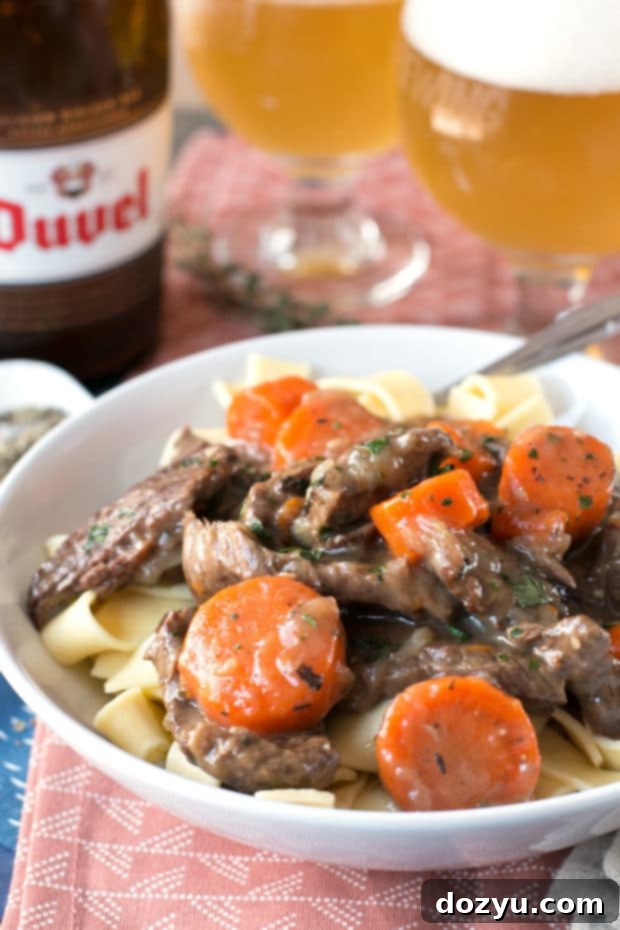
Yes, I mean actually simple. Not “simple” in the way a master chef on a cooking show might casually suggest you “just whip up your own rosemary foam from scratch and present it on a bed of microgreens.” We’ve all been there, watching “Top Chef” reruns and thinking, “Yeah, right, that’s definitely not for my weeknight dinner!” This recipe, however, genuinely falls into the easy-to-follow category, producing extraordinary, restaurant-quality results without requiring specialized skills or an extensive culinary background. It’s all about letting good ingredients do the work over time.
The magic of this actually simple recipe lies in a masterful combination of key ingredients and patient cooking. The rich flavor of the stew comes predominantly from two main stars: the carefully chosen Belgian golden ale and the perfectly balanced Italian Seasoning from Sprouts. These two elements, along with fresh aromatics like onions and garlic, build a deeply satisfying base that requires minimal fuss and maximum flavor development during its slow simmer.
The Secret to Unforgettable Flavor: Quality Ingredients from Sprouts
A truly great stew starts with exceptional ingredients, and that’s precisely where Sprouts Farmers Market truly shines. Our Carbonnades à la Flamande recipe leverages the quality of Sprouts’ offerings, ensuring every bite is packed with incredible, wholesome flavor.
Sprouts Beef Chuck Roast: The Foundation of Tenderness and Taste
The foundation of this deeply satisfying Carbonnades à la Flamande is a high-quality Sprouts beef chuck roast. This cut of beef is absolutely ideal for slow-cooking because it contains connective tissues that, over several hours of gentle heat, break down into rich gelatin. This process results in incredibly tender, succulent, and juicy beef that practically melts in your mouth. When sliced thinly, as recommended for this recipe (into 2-inch by 4-inch pieces that are 1/2-inch thick), it transforms into delightful, fork-tender morsels that readily absorb all the intricate liquids and spices of the stew. The inherent quality of the beef from Sprouts ensures a robust, authentic beefy flavor that proudly stands up to the bold, malty notes of the Belgian beer, contributing significantly to the stew’s overall richness.
Sprouts Italian Seasoning: A Kitchen Game-Changer from the Bulk Section
If you haven’t yet explored the bulk seasoning section at your local Sprouts, you are truly missing out on a culinary revelation! It’s my personal version of spice heaven, offering not just all my go-to standard spices like paprika, cumin, and garlic powder, but also incredible, expertly blended pre-mixed combinations, such as the fantastic Italian Seasoning used in this recipe. This blend is an absolute lifesaver, allowing you to bypass the need to measure out five different individual spices like oregano, basil, thyme, rosemary, and marjoram. Sprouts conveniently takes care of that “nonsense” for you, providing a perfectly balanced, aromatic spice mix ready for immediate use, any time of year. This not only saves time but guarantees a consistent, delicious flavor profile every time you cook.

I absolutely adore how this particular Italian seasoning blend harmonizes with the naturally sweet caramelized onions, earthy carrots, pungent garlic, and the distinctive, complex notes of the Belgian beer in this stew. It creates a robust yet perfectly balanced flavor profile that is deeply satisfying without ever being overwhelming. The stew strikes a perfect balance: it’s rich, savory, and profoundly flavorful, yet manages to avoid feeling overly heavy, making it a wonderfully comforting meal that nourishes both body and soul without weighing you down. The interplay of these fresh ingredients and quality spices is what truly elevates this dish.

And let’s not forget the Sprouts beef chuck roast, which, after hours of slow simmering, cooks down to such a tender and delightful mouthful of comfort. Each bite is like stepping into a quaint, bustling brasserie in the middle of Paris, enjoying generations of culinary tradition, even though the flavors are distinctly Flemish. It’s a powerful testament to how simple, high-quality ingredients, when prepared with patience and a touch of passion, can create a truly transportive culinary experience right in your own kitchen.
Serving Suggestions for Your Perfect Belgian Beer Beef Stew
While the Carbonnades à la Flamande is undeniably the star of the show, how you choose to serve it can truly elevate the entire meal. Personally, I find that serving this rich and hearty stew over perfectly buttered noodles is an unbeatable option. The soft, tender, buttery noodles absorb every drop of the exquisite beer-infused sauce, making for an incredibly satisfying and comforting combination that’s hard to resist.
However, the versatility of this delicious stew means you have many other fantastic options. You can serve it straight up, perhaps with a side of thick-cut, crusty toasted bread or a fresh baguette. This allows you to soak up every last drop of the flavorful broth, ensuring no culinary goodness goes to waste. Another fantastic choice is alongside crispy roasted potatoes, which provide a lovely textural contrast to the tender beef, or even a mound of creamy mashed potatoes, which offer a smooth, comforting base for the rich stew. Don’t hesitate to experiment with different starches or even a simple green salad to find your perfect pairing that complements the deep flavors of the Carbonnades.
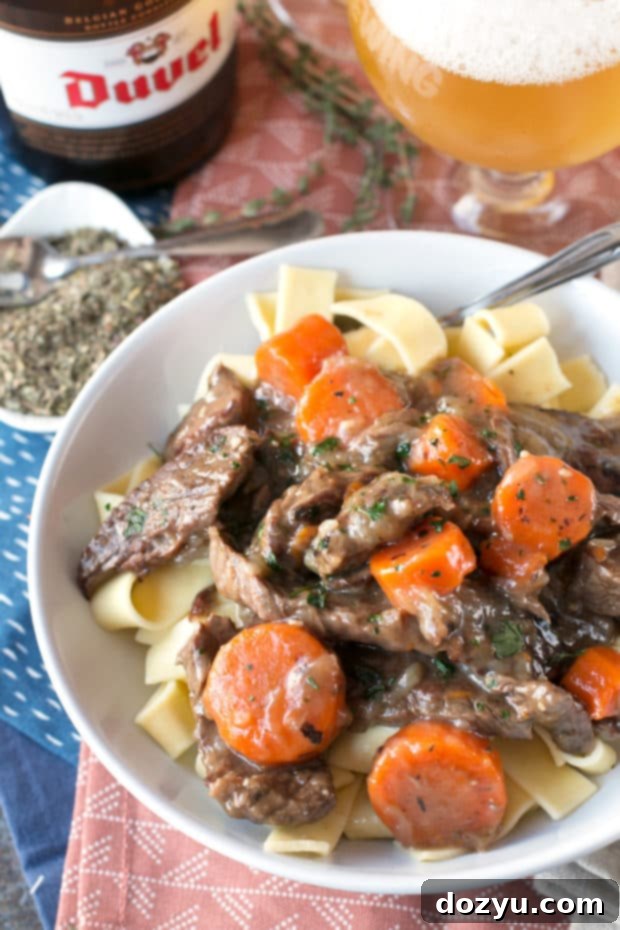
Tips for Making the Best Carbonnades à la Flamande
To ensure your Belgian Beer Beef Stew turns out perfectly every time, consider these helpful tips:
- Choose the Right Beer Wisely: While a Belgian Golden Ale like Duvel is an excellent choice for its balanced malty and slightly bitter profile, other styles can also work beautifully. Consider an amber ale for a slightly sweeter, nuttier flavor, or even a strong dark ale for a richer, more robust stew. Avoid anything too hoppy (like an IPA) or overly sweet (like some fruit beers), as these can overpower or unbalance the delicate flavors of the stew. The goal is a malty, slightly bitter, and well-rounded flavor that enhances, not dominates, the beef.
- Don’t Rush the Browning Process: Browning the beef in batches is a crucial step. It ensures a deep, rich sear on all sides of the meat, which locks in moisture and develops intense flavor. The caramelized bits that stick to the bottom of the pan (the “fond”) are packed with umami and will form the delicious base of your sauce. Crowding the pan will steam the meat instead of browning it, so take your time and work in smaller batches if necessary.
- Scrape the Pan for Flavor: When you add the beef stock to the skillet after browning the meat and vegetables, make sure to vigorously scrape up all those flavorful browned bits from the bottom of the pan. This deglazing process releases concentrated flavors into your broth, adding incredible depth to the finished stew.
- Slow and Low is Key for Tenderness: The long, slow cooking time in the oven is absolutely crucial for tenderizing the beef chuck roast. This extended simmering at a low temperature allows the tough connective tissues in the meat to break down slowly, resulting in impossibly tender, fall-apart beef. Resist the urge to rush it by increasing the heat, as this will lead to tough, dry meat. Patience is your best friend here!
- Taste and Adjust Seasoning: Before serving, always taste your stew. Flavors can change during slow cooking, and you might find it needs a little more salt, freshly ground black pepper, or even a touch more red wine vinegar for a bright, acidic lift that cuts through the richness. Adjust according to your personal preference.
- Consider Making It Ahead: Like many stews and braised dishes, Carbonnades à la Flamande often tastes even better the next day. This allows the flavors more time to meld and deepen, creating an even more harmonious and delicious meal. It’s a fantastic make-ahead option for entertaining or for enjoying throughout the week. Store it in an airtight container in the refrigerator for up to 3-4 days.
So, whether you’re celebrating Bastille Day with a nod to Franco-Belgian culinary history, craving a taste of European comfort on a chilly evening, or simply in the mood for an incredibly satisfying and surprisingly straightforward meal, Carbonnades à la Flamande is a recipe that truly delivers. It’s a harmonious blend of French culinary tradition and Belgian brewing artistry, resulting in a dish that is both hearty and refined, deeply flavorful, and wonderfully comforting. Vive la France! Vive la Belgique! And most importantly, vive allllll the delicious beer that makes such culinary wonders possible!

Carbonnades à la Flamande (Belgian Beer Beef Stew)
ingredients
- 3 lb Sprouts beef chuck roast sliced into 2-inch by 4-inch pieces that are ½-inch thick
- 2 to 3 Tbsp bacon fat
- 2 large yellow onions sliced
- 4 cloves garlic mashed
- 1 tsp freshly diced shallot
- 1 cup beef stock
- 2 1/2 cups Belgian beer I used Duvel Belgian Golden Ale
- 1 tsp light brown sugar
- 1 bay leaf
- 2 springs fresh thyme
- 1 1/2 tsp Sprouts Italian seasoning
- 1 1/2 Tbsp cornstarch
- 2 Tbsp red wine vinegar
- Buttered noodles
- Garnish: chopped fresh parsley
instructions
-
Preheat oven to 325 degrees.
-
Add bacon fat to a large cast-iron skillet. Heat over medium-high heat. Brown the beef slices on both sides, working in batches and removing to a plate once browned.
-
Reduce to medium heat. Stir in the onions and carrots. Brown vegetables for approximately 10 minutes, stirring frequently. Remove from heat and season with salt, pepper and garlic.
-
Add half of the meat to a large Dutch oven. Top with half of the onions and carrots. Add a final layer of meat, followed by a final layer of the onions and carrots.
-
Add beef stock to the cast-iron skillet you cooked the beef and vegetables in. Warm the broth over medium heat, stirring and scraping the bottom of the pan to get all the good bits into the broth.
-
Pour the warmed broth over the meat and vegetables. Top with beer. Stir in sugar, bay leaf, thyme, and Italian seasoning.
-
Bring mixture to a boil on the stove. Cover and place in the oven to cook for approximately 2 ½ hours.
-
Remove Dutch oven to the stove. Pick out thyme sprigs and bay leaf.
-
Stir together cornstarch and red wine vinegar in a small bowl until combined. Stir into the stew and simmer for 4 to 5 minutes over medium-high heat.
-
Season with salt and pepper to taste. Serve immediately.
